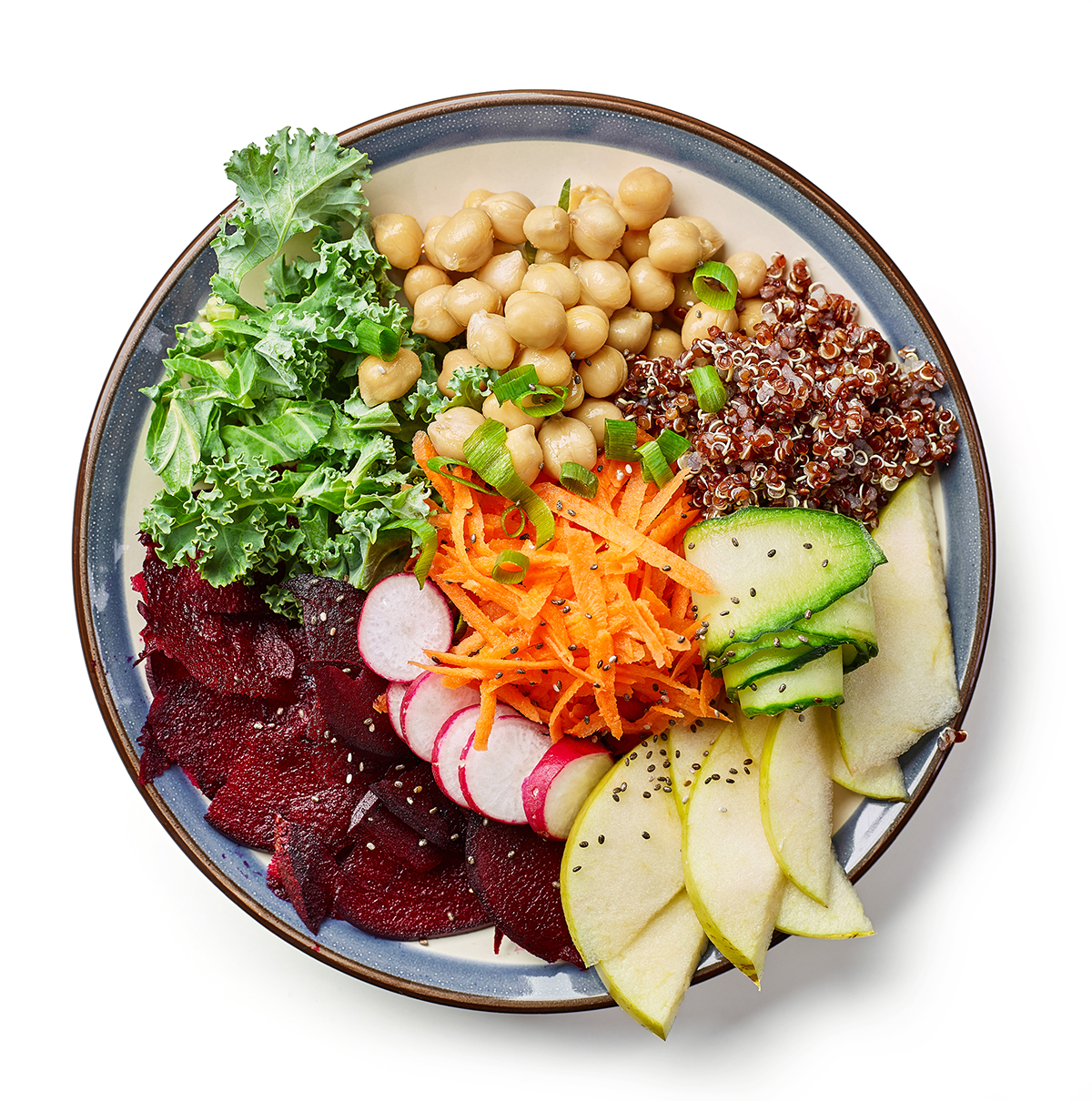Love Your Veggies
June is National Fruit and Vegetables Month and June 17 is National Eat your Veggies Day! If you learn about the health benefits of vegetables you may be more excited about eating your veggies. Read on for more tips about to help you get more healthy veggies into your meals.
Examples of non-starchy vegetables are leafy greens, lettuce, mushrooms, onions, broccoli, cabbage, zucchini, tomatoes. Yeah, yeah, I know tomatoes are a fruit. So are cucumbers and peppers, but we’re talking nutrition here, not botany. Basically all the vegetables in the produce aisle are non-starchy, except for potatoes, sweet potatoes, yams, corn, pumpkin and hard rind winter squash. And only olives and avocados are high in fat.
Fruits and starchy vegetables have many of the same nutrients and benefits, they just have a higher sugar and starch content which ups the calories and the glycemic index number. Diabetics can eat non-starchy vegetables with higher glycemic foods to lower the glycemic effect of the meal.
You’ve probably heard the old advice to eat five servings of fruits and vegetables a day, but to get the most health benefits, aim for 11 servings. Rather than measuring your food, just think of a serving as the size of your fist. The bigger your fist is, the more fruits and vegetables you should be eating. To get 11 servings in a day you’ll need to work them into every meal and snacks too.
If you’re going to overeat something, make it non-starchy vegetables. They are:
- Loaded with vitamins, minerals and phytochemicals that keep making news for their disease fighting properties
- Anti-inflammatory and anti-pain compounds related to aspirin
- Vegetarian, if you’re one of the growing group of people eating more and more vegetarian foods
- Low in calories, usually about 25 calories per 1/2 cup cooked or 1 cup raw.
- Low in carbs (about 5 grams per serving)
- Low on the glycemic index (under 20) which means they don’t really affect your blood sugar
- Low in fat (a trace which is hardly any)
Tips for choosing veggies
- Eat baby veggies. They’re sweeter and more tender. Try baby beets, eggplants, spinach, bok choy, artichokes and don’t forget the cherry tomatoes. Baby carrots are the ones with the tops still on. The little ones in bags are regular carrots all chopped up.
- Eat the sweet ones. Sweet onions (Vidalia, Texas 1015, Maui), parsnips, carrots, yams, sweet potatoes, red peppers, sweet corn, butternut squash all add sweetness to a meal.
- Try heirloom veggies. What they lack in looks, they make up in flavor.
- Go to a farmer’s market. Fresh and in season are always better. Request to make sure its organic.
- Try different varieties and hybrids. More and more exotic veggies (and fruits) are showing up in supermarkets. Buy whatever looks interesting, then look up recipes on the Internet when you get home.
- Go organic. Organic produce is often the best quality these days. And it’s not genetically modified as some non-organic produce is. Think organic is too expensive? Try adding up what you spend on eating out and frozen entreés to put the cost of organic in perspective. Organic has more nutrients and more nutrients mean more flavor.
Tips for cooking veggies
- Stir-fry them in a tablespoon of olive oil. Add a protein, serve over a bed of whole grains and you’ve got a delicious meal. By putting the veggies in the main dish, you can’t help but eat a more balanced meal.
- Blanch them. Quickly dropping bitter greens into boiling water for 30 to 60 seconds, then dropping them in ice water to stop the cooking will remove some of the bitter flavor. Blanching is the secret to great tasting vegetables in Chinese food.
- Salad and crudité. Dip raw or blanched veggies in creamy Italian or dill dressing or any of your favorite salad dressings.
- Roast or grill them. Roasting and grilling concatenates the flavors, adds a crispy texture and caramelizes some of the sugars creating a sweeter taste. Line a sheet pan with parchment paper for easy clean-up.
- Cook cabbage and Brussels sprouts quickly. The objectionable smells come from compounds created after five minutes of cooking. Shred or slice the cabbage finely so it will get tender quickly. Cut Brussels sprouts in halves or quarters.
- Make soups and stews. Slowly simmering soup mellows out the flavors and brings out the sweetness. Vegetables that are limp, but not rotten or moldy, can be used in soup and no one will be the wiser.
- Add more vegetables to your regular recipes.
Get creative with veggies
- Add herbs and spices. Start with a good all-purpose seasoned salt or salt-free vegetable seasoning.
- Keep trying new recipes. You might find a delicious way to eat a veggie you thought you hated.
- Hide them. Add shredded carrots and onions to hash browns; mashed parsnips to mashed potatoes, shredded or finely diced veggies to veggie burgers. Get creative. Don’t forget dessert. Carrot cake, zucchini bread, pumpkin pie, sweet potato pie. Yum.
- Go nutty. A few chopped peanuts, sunflower seeds, slivered almonds, etc. will add another layer of flavor and texture.
- Try different textures. If you object to a texture, try a different one — raw, chunks, puree, soft, tender crisp. Even juice is an option, though you lose the fiber in the processing.
- Add tomato sauce or salsa will add another layer of flavor and texture. Spaghetti sauce, ketchup and salsa count as vegetables too.
Save time
Buy them pre-washed and pre-chopped. More and more veggies (and fruits) can be purchased pre-washed and precut. Try salad blends, spinach, cole slaw mix, mushrooms, baby carrots, celery sticks. Pre-chopped garlic comes in glass jars.
- Canned is OK too. Canned tomatoes, jarred spaghetti sauce and salsa are pantry staples. If fresh artichokes are too intimidating, try the marinated ones in jars. Roasted red peppers in jars are tasty addition to hummus. Try giardiniera to add some hot and spicy zing. Make an Asian stir fry with cans of baby corn, water chestnuts and bamboo shoots.
- Frozen is ready when you are. Frozen vegetables very convenient and have more nutrients and flavor than fresh veggies that have been hanging around too long. Try bags of vegetable mixtures or individual beans, peas, carrots, winter squash, corn, edamame (young soybeans). You can also buy onions and peppers ready to add to your own recipes without the knife work (or tears). Try out-of-season fruits too.
Store your produce properly
At the very least, store vegetables away from fruits. Many fruits, including bananas, tomatoes and avocados, give off ethylene gas which makes some veggies turn bitter, limp or off-color so it’s important to separate the ethylene producers from the ethylene sensitive produce. Remove any rubber bands or twist-ties before storing. If you can, store things from different groups separately.
High moisture Loss: Refrigerate immediately.
- Asparagus — Cut the stems with a sharp knife and put them in a glass of water. Put a plastic bag loosely over the top. Change the water every day or two.
- Broccoli
- Brussels Sprouts
- Cauliflower
- Corn
- Green Onions
- Mushrooms
- Peas
Moderate Moisture Loss: Refrigerate immediately.
- Beets
- Cabbage
- Carrots
- Celery
- Cucumber
- Eggplant
- Green beans
- Greens — spinach, kale, collards
- Herbs — Wash them, cut the stems with a sharp knife and put in a glass of water with a plastic bag loosely over the top. They will keep several days on the counter like fresh flowers, but will last longer in the frig. Change the water every day or two.
- Lettuce — If not pre-washed, wash and spin in a salad spinner. Put the spinner in the refrigerator. The lettuce will be dry and crisp within a couple of hours. It will keep fresh and ready to use for several days. You can revive limp lettuce this way too. Green leaf lettuce stays “unslimy” longer than red leaf lettuce.
- Okra
- Peppers
- Summer squash with a soft rind — zucchini and yellow summer squash
- Turnips
- Low Moisture Loss: Refrigerate immediately. Do not wash until ready to eat.
- Berries — blackberries, blueberries, raspberries, strawberries
- Citrus fruits — grapefruit, lemons, limes, tangerines, oranges
- Grapes
- Sweet onions — Maui, Texas 1015, Vidalia
Low Moisture: Allow to ripen at room temperature before refrigerating. Letting them come to room temperature before eating will improve the flavor. This group gives off ethylene gas and is also sensitive to ethylene gas. Putting them in a paper bag will concentrate the gas and make them ripen faster.
- Apples
- Apricots
- Avocados — be especially careful to avoid bruising; ripening with ethylene gas gives avocados an unappealing brown color inside (Upscale and ethnic markets are more likely to carry naturally ripened avocados.)
- Bananas — the peels will turn black in the refrigerator but the bananas will not continue to ripen and will still be good to eat
- Kiwi fruit
- Mangoes
- Melons — cantaloupe, honeydew, watermelon
- Peaches and nectarines
- Pears
- Pineapple
- Plums
- Pluots — a very delicious cross between a plum and an apricot
- Tomatoes
Low Moisture: Store in a cool, dry place, not the refrigerator.
- Garlic
- Ginger root
- Storage onions — the ones with dry papers on the outside
- Potatoes, sweet potatoes and yams
- Shallots
- Winter squash with a hard rind — acorn, butternut, delicata
 Ramon & Jeanette ‘Jen’ Mascarenas of PalmLeaf Massage Clinic. Jen Mascarenas is a vegan and believes in a whole-foods, plant-based diet to promote vitality. She shares vegan recipes and writes abstract research articles for PalmLeaf Massage Clinic. Ramon Mascarenas and his associates have licensed massage therapist who practices Myofascial Trigger Point Therapy and other medical massage modalities. Ramon and his associates promote wellness and help clients with pain management through self-care exercises.
Ramon & Jeanette ‘Jen’ Mascarenas of PalmLeaf Massage Clinic. Jen Mascarenas is a vegan and believes in a whole-foods, plant-based diet to promote vitality. She shares vegan recipes and writes abstract research articles for PalmLeaf Massage Clinic. Ramon Mascarenas and his associates have licensed massage therapist who practices Myofascial Trigger Point Therapy and other medical massage modalities. Ramon and his associates promote wellness and help clients with pain management through self-care exercises.

